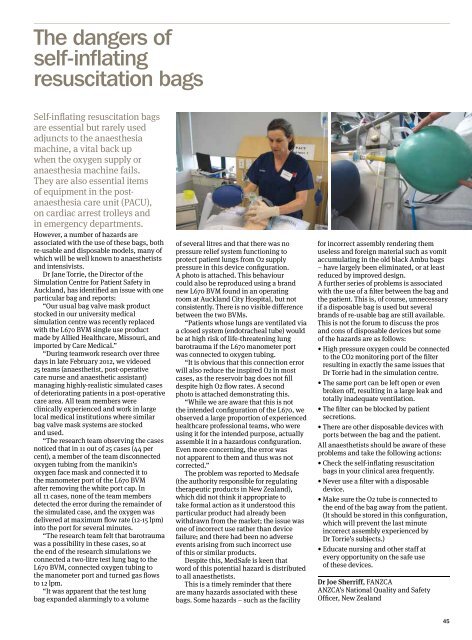ANZCA Bulletin June 2012 - final.pdf - Australian and New Zealand ...
ANZCA Bulletin June 2012 - final.pdf - Australian and New Zealand ...
ANZCA Bulletin June 2012 - final.pdf - Australian and New Zealand ...
- No tags were found...
You also want an ePaper? Increase the reach of your titles
YUMPU automatically turns print PDFs into web optimized ePapers that Google loves.
The dangers ofself-inflatingresuscitation bagsSelf-inflating resuscitation bagsare essential but rarely usedadjuncts to the anaesthesiamachine, a vital back upwhen the oxygen supply oranaesthesia machine fails.They are also essential itemsof equipment in the postanaesthesiacare unit (PACU),on cardiac arrest trolleys <strong>and</strong>in emergency departments.However, a number of hazards areassociated with the use of these bags, bothre-usable <strong>and</strong> disposable models, many ofwhich will be well known to anaesthetists<strong>and</strong> intensivists.Dr Jane Torrie, the Director of theSimulation Centre for Patient Safety inAuckl<strong>and</strong>, has identified an issue with oneparticular bag <strong>and</strong> reports:“Our usual bag valve mask productstocked in our university medicalsimulation centre was recently replacedwith the L670 BVM single use productmade by Allied Healthcare, Missouri, <strong>and</strong>imported by Care Medical.”“During teamwork research over threedays in late February <strong>2012</strong>, we videoed25 teams (anaesthetist, post-operativecare nurse <strong>and</strong> anaesthetic assistant)managing highly-realistic simulated casesof deteriorating patients in a post-operativecare area. All team members wereclinically experienced <strong>and</strong> work in largelocal medical institutions where similarbag valve mask systems are stocked<strong>and</strong> used.“The research team observing the casesnoticed that in 11 out of 25 cases (44 percent), a member of the team disconnectedoxygen tubing from the manikin’soxygen face mask <strong>and</strong> connected it tothe manometer port of the L670 BVMafter removing the white port cap. Inall 11 cases, none of the team membersdetected the error during the remainder ofthe simulated case, <strong>and</strong> the oxygen wasdelivered at maximum flow rate (12-15 lpm)into the port for several minutes.“The research team felt that barotraumawas a possibility in these cases, so atthe end of the research simulations weconnected a two-litre test lung bag to theL670 BVM, connected oxygen tubing tothe manometer port <strong>and</strong> turned gas flowsto 12 lpm.“It was apparent that the test lungbag exp<strong>and</strong>ed alarmingly to a volumeof several litres <strong>and</strong> that there was nopressure relief system functioning toprotect patient lungs from O2 supplypressure in this device configuration.A photo is attached. This behaviourcould also be reproduced using a br<strong>and</strong>new L670 BVM found in an operatingroom at Auckl<strong>and</strong> City Hospital, but notconsistently. There is no visible differencebetween the two BVMs.“Patients whose lungs are ventilated viaa closed system (endotracheal tube) wouldbe at high risk of life-threatening lungbarotrauma if the L670 manometer portwas connected to oxygen tubing.“It is obvious that this connection errorwill also reduce the inspired O2 in mostcases, as the reservoir bag does not filldespite high O2 flow rates. A secondphoto is attached demonstrating this.“While we are aware that this is notthe intended configuration of the L670, weobserved a large proportion of experiencedhealthcare professional teams, who wereusing it for the intended purpose, actuallyassemble it in a hazardous configuration.Even more concerning, the error wasnot apparent to them <strong>and</strong> thus was notcorrected.”The problem was reported to Medsafe(the authority responsible for regulatingtherapeutic products in <strong>New</strong> Zeal<strong>and</strong>),which did not think it appropriate totake formal action as it understood thisparticular product had already beenwithdrawn from the market; the issue wasone of incorrect use rather than devicefailure; <strong>and</strong> there had been no adverseevents arising from such incorrect useof this or similar products.Despite this, MedSafe is keen thatword of this potential hazard is distributedto all anaesthetists.This is a timely reminder that thereare many hazards associated with thesebags. Some hazards – such as the facilityfor incorrect assembly rendering themuseless <strong>and</strong> foreign material such as vomitaccumulating in the old black Ambu bags– have largely been eliminated, or at leastreduced by improved design.A further series of problems is associatedwith the use of a filter between the bag <strong>and</strong>the patient. This is, of course, unnecessaryif a disposable bag is used but severalbr<strong>and</strong>s of re-usable bag are still available.This is not the forum to discuss the pros<strong>and</strong> cons of disposable devices but someof the hazards are as follows:• High pressure oxygen could be connectedto the CO2 monitoring port of the filterresulting in exactly the same issues thatDr Torrie had in the simulation centre.• The same port can be left open or evenbroken off, resulting in a large leak <strong>and</strong>totally inadequate ventilation.• The filter can be blocked by patientsecretions.• There are other disposable devices withports between the bag <strong>and</strong> the patient.All anaesthetists should be aware of theseproblems <strong>and</strong> take the following actions:• Check the self-inflating resuscitationbags in your clinical area frequently.• Never use a filter with a disposabledevice.• Make sure the O2 tube is connected tothe end of the bag away from the patient.(It should be stored in this configuration,which will prevent the last minuteincorrect assembly experienced byDr Torrie’s subjects.)• Educate nursing <strong>and</strong> other staff atevery opportunity on the safe useof these devices.Dr Joe Sherriff, F<strong>ANZCA</strong><strong>ANZCA</strong>’s National Quality <strong>and</strong> SafetyOfficer, <strong>New</strong> Zeal<strong>and</strong>45
















